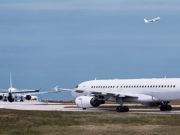
The accident rate for the world’s commercial airline industry declined in 2017 to 1.08 accidents per million flights, down from the previous year’s rate of 1.68 and well below the average rate of 2.01 for the five-year period from 2012 through 2016, according to new data from the International Air Transport Association (IATA).
In a report released in late February, IATA said commercial airliners were involved in six fatal accidents in 2017 that killed a total of 19 passengers and crewmembers. In comparison, in 2016, there were nine fatal accidents and 202 fatalities (Table 1), 2017 Safety Performance and in 2012–2016, commercial jet airliners were involved in an average of 10.8 fatal accidents with 315 fatalities per year, the report said.
| 2017 | 2016 | 2012–2016 | |
|---|---|---|---|
Source: International Air Transport Association |
|||
| On-board Fatalities1 | 19 | 202 | 314.6 |
| Total Accidents | 45 | 67 | 74.8 |
| Fatal Accidents | 6 | 92 | 10.8 |
| Fatality Risk3 | 0.09 | 0.21 | 0.24 |
| Fatal Accidents, Passenger Flights | 2 | 3 | 5.6 |
| Fatal Accidents, Cargo Flights | 4 | 6 | 4.6 |
| % of accidents involving fatalities | 13.3 | 13.4 | 14.4 |
| Jet hull losses | 4 | 13 | 10 |
| Jet hull losses with fatalities | 1 | 4 | 3.4 |
| Turboprop hull losses | 9 | 7 | 15 |
| Turboprop hull losses with fatalities | 5 | 4 | 7.2 |
The data showed that none of the six fatal accidents in 2017 involved a passenger jet. Five fatal accidents involved turboprop airplanes and one accident — which also killed 35 people on the ground — involved a cargo jet.
“2017 was a very good year for aviation safety,” said IATA Director General and CEO Alexandre de Juniac. “Some 4.1 billion travelers flew safely on 41.8 million flights. We saw improvements in nearly all key metrics — globally and in most regions. And our determination to make this very safe industry even safer continues. In 2017, there were incidents and accidents that we will learn from through the investigation process, just as we will learn from the recent tragedies in Russia and Iran.”
De Juniac referred to the Feb. 18 crash of an Iran Aseman ATR 72 near Yasuj, Iran, that killed all 72 passengers and crewmembers and the Feb. 11 crash of a Saratov Airlines Antonov An-148 near Moscow that killed all 71 occupants.
“Complementing [the knowledge derived from accident investigations] are insights we can gain from the millions of flights that operate safely,” de Juniac added. “Data from these operations is powering the development of predictive analytics that will eventually enable us to eliminate the conditions that can lead to accidents. The industry knows that every fatality is a tragedy. Our common goal is for every flight to take off and land safely.”
The 2017 commercial airline accidents carried a “fatality risk” of 0.09, meaning that a passenger would have to take one flight every day for 6,033 years before experiencing a fatal accident. The fatality risk is designed to measure “the exposure of a passenger or crew to a catastrophic accident where all people on board the flight are killed,” IATA said. “The calculation does not take into account aircraft size or how many were on board. What is measured is the percentage of those on board who were killed.”
The accident rate for major jet accidents in 2017 was 0.11 per million flights, or the equivalent of one major accident every 8.7 million flights, well below the 2016 rate of 0.39 per million flights and the five-year average of 0.33. Half of the world’s regions recorded no jet hull losses in 2017, including Africa, which had a hull loss rate in 2012–2016 of 2.21 per million departures (Table 2).
| 2012 | 2013 | 2014 | 2015 | 2016 | 2017 | 2012–2016 | |
|---|---|---|---|---|---|---|---|
| Source: International Air Transport Association | |||||||
| Africa | 5.84 | 0.00 | 1.86 | 3.53 | 0.00 | 0.00 | 2.21 |
| Asia Pacific | 0.49 | 0.69 | 0.44 | 0.21 | 0.58 | 0.18 | 0.48 |
| Commonwealth of Independent States | 1.09 | 1.96 | 0.94 | 1.89 | 0.00 | 0.92 | 1.17 |
| Europe | 0.15 | 0.00 | 0.14 | 0.14 | 0.27 | 0.13 | 0.14 |
| Latin America and the Caribbean | 0.47 | 0.46 | 0.44 | 0.42 | 0.80 | 0.41 | 0.53 |
| Middle East and North Africa | 0.00 | 1.30 | 0.62 | 0.00 | 1.67 | 0.00 | 0.74 |
| North America | 0.00 | 0.32 | 0.11 | 0.33 | 0.32 | 0.00 | 0.22 |
| North Asia | 0.00 | 0.00 | 0.00 | 0.00 | 0.00 | 0.00 | 0.00 |
| Industry | 0.28 | 0.38 | 0.26 | 0.32 | 0.39 | 0.11 | 0.33 |
| IATA Member Airlines | 0.00 | 0.31 | 0.00 | 0.22 | 0.30 | 0.00 | 0.17 |
IATA defines a hull loss as “an accident in which the aircraft is destroyed or substantially damaged and is not subsequently repaired for whatever reason, including a financial decision of the owner.”
The three other regions without jet hull losses were the Middle East and North Africa, down from 0.53 hull losses per million departures in 2012–2016; North America, down from 0.22 hull losses per million departures in 2012–2016; and North Asia, which had a rate of zero jet hull losses in 2012–2016.
The world turboprop hull loss rate in 2017 was 1.30 per million flights, an increase from 1.01 per million in 2016 but still below the five-year rate of 2.18, the report said. Data showed that accidents involving turboprop airplanes accounted for 44 percent of all accidents — and 83 percent of fatal accidents — in 2017 (Table 3).
| 2012 | 2013 | 2014 | 2015 | 2016 | 2017 | 2012–2016 | |
|---|---|---|---|---|---|---|---|
| Source: International Air Transport Association | |||||||
| Africa | 16.62 | 4.96 | 12.98 | 1.58 | 1.52 | 5.70 | 7.38 |
| Asia Pacific | 2.07 | 2.05 | 0.00 | 2.01 | 1.16 | 0.61 | 1.45 |
| Commonwealth of Independent States | 21.55 | 22.89 | 29.43 | 0.00 | 26.59 | 16.44 | 20.59 |
| Europe | 0.69 | 2.22 | 0.73 | 0.00 | 0.00 | 0.00 | 0.73 |
| Latin America and the Caribbean | 2.54 | 3.83 | 1.20 | 0.00 | 0.00 | 0.00 | 1.55 |
| Middle East and North Africa | 8.17 | 0.00 | 8.52 | 0.00 | 0.00 | 0.00 | 3.42 |
| North America | 1.30 | 1.31 | 1.32 | 0.46 | 0.47 | 0.94 | 0.98 |
| North Asia | 11.40 | 0.00 | 11.18 | 22.47 | 0.00 | 0.00 | 8.73 |
| Industry | 3.45 | 2.63 | 2.75 | 1.04 | 1.01 | 1.30 | 2.18 |
| IATA Member Airlines | 1.80 | 0.95 | 0.81 | 0.79 | 1.41 | 0.00 | 1.15 |
Regionally, the 2017 turboprop hull loss rate was highest — 16.44 per million sectors — in the Commonwealth of Independent States. In comparison, the region’s 2016 rate was 26.59, and the five-year rate was 20.59 per million sectors.
The second-highest rate was in Africa, which recorded 5.70 hull losses per million flight sectors, compared with a 2016 rate of 1.52 and a five-year rate of 7.38, the report said.
Despite the year’s increase in the turboprop hull loss rate, the Africa region, which encompasses sub-Saharan Africa, continued its “strong progress on safety,” the report said.
“For a second year in a row, airlines in the region experienced no passenger fatalities and no jet hull losses,” the report added. “But there is still a large gap to cover in the safety performance of the continent’s turboprop fleet.”
The report credited worldwide standards, including the IATA Operational Safety Audit (IOSA), with contributing to the ongoing safety improvements, noting that the safety records of African airlines on the IOSA registry were “more than three times better than non-IOSA airlines in the region.”
The report recommended that African governments accelerate their implementation of safety-related standards and recommended practices (SARPs) put forth by the International Civil Aviation Organization. At the close of 2017, only 25 countries in the African region had SARPs implementation rates of 60 percent or more, the report said.
The document also noted that the 2017 all-accident rate for airlines on the IOSA registry was 0.56 per million flights — almost four times better than the rate of 2.17 recorded by airlines not on the registry.


